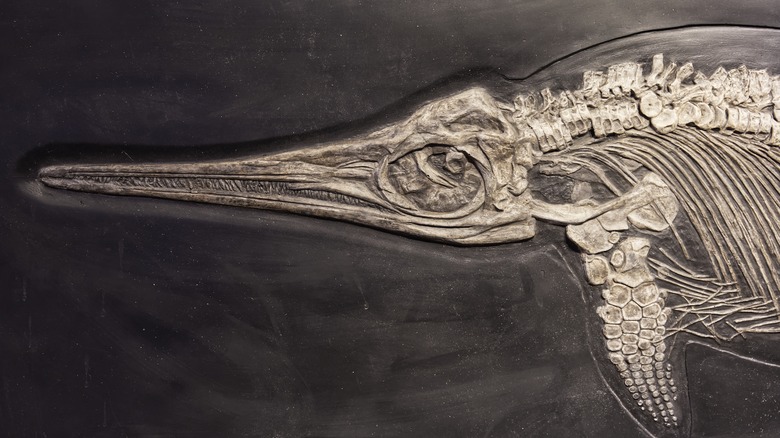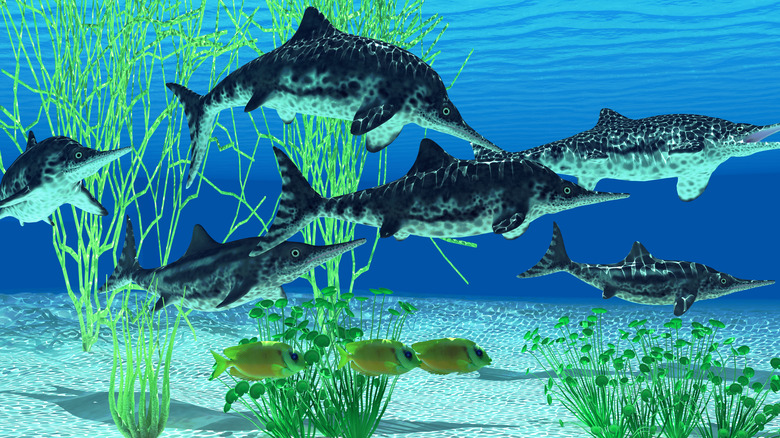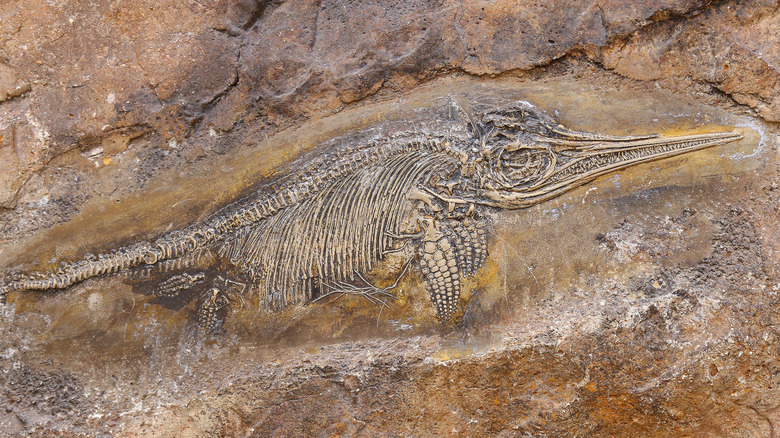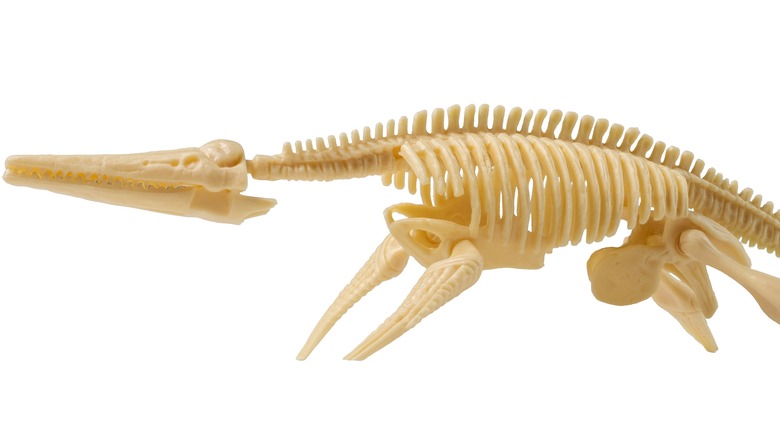Paleontologists Have A Better Understanding Of This Icthyosaurs Mass Grave In Nevada
Dinosaurs continue to have an enormous sway over our imaginations. When Sam Neill's character in "Jurassic Park," Dr. Alan Grant, reacted with spectacle-removing wonderment to seeing his first living dinosaur in the flesh, he reacted for all of us. The movies, all in all, do a great job of embodying the combination of astonishment, wonder, and sheer terror that would actually result from seeing one of these magnificent creatures in real life (were it ever to be possible).
What the franchise also does, however, is play rather fast and loose with science at times. True velociraptors, National Geographic reports, were much smaller, weighing 100 pounds or so. They also reportedly sported feathers, somewhat more as they did later in the movie series. In the name of blockbuster moviemaking, jump scares, horror, and excitement can out-prioritize stuffy facts. This is not simply the fault of author Michael Crichton, Steven Spielberg or anyone else, however: thanks to the tireless and fascinating work of paleontologists, our understanding of dinosaurs and the other fascinating prehistoric creatures with which they shared the planet is advancing all the time.
One such group of creatures was the ocean-dwelling ichthyosaurs. Like many of these now-extinct creatures, they're quite unlike anything that survives today in lots of ways. Nevertheless, one particular mass grave of ichthyosaurs seems to reveal that their habits live on even today. Dinosaurs, per the Natural History Museum, existed for a very, very long time indeed. A span of around 179 million years, approximately.
The mysterious icthyosaur graveyard
This means, of course, that some of the most iconic species, such as the Tyrannosaurus rex and the Stegosaurus, would not have existed in the same timeframe. "There's about just as much time between us and T. rex as there is between T. rex and Stegosaurus, so they never would have met each other," Museum of Science's Katie told the "Pulsar" podcast.
The Cretaceous period, Britannica reports, lasted 79 million years, and came to an end 65 million years ago in the great extinction event that doomed the dinosaurs. During this long span, the period saw appearances from some of the most iconic dinosaurs, including Triceratops and, per National Geographic, the aforementioned Tyrannosaurus rex, which lived during the late Cretaceous (approximately 68 million years ago).
During the long span of the Cretaceous period, these icons were joined by at least one species of ichthyosaur: Malawania anachronus. The August 2013 study, "A basal thunnosaurian from Iraq reveals disparate phylogenetic origins for Cretaceous ichthyosaurs" from Valentin Fischer et al, states that this species was discovered in "the Early Cretaceous of Iraq." This suggests that, as Britannica reports, it lived around 145 million years ago, when the period began.
Ichthyosaurs were not dinosaurs, but their tremendous age (they became extinct with the dinosaurs about 65 million years ago, per Britannica) means that the fossilized remains of these large (around 10 feet or 3 meters long) dolphin-esque sea creatures have frequently been studied by experts.
A long legacy
A recent discovery surrounding a mysterious mass grave of icthyosaurs, however, seems to demonstrate that these creatures didn't just resemble the ocean-dwellers of today: their birthing habits were similar to some species too. In December 2022, CNN reported that the remains of numerous icthyosaurs, a gigantic species known as Shonisaurus popularis (which reached 50 feet or 15.2 meters in length), had been discovered in Nevada. What became of these enormous creatures? Why did they all die together?
The recently published study, "Grouping behavior in a Triassic marine apex predator" from Neil P. Kelley et al, seems to have found the answer. "A concentration of at least seven skeletons closely preserved on a single bedding plane received the bulk of previous attention," the study notes, regarding the prior investigation of this area of Nevada's West Union Canyon. Information from such, it seems, was incomplete, and so, per CNN, factors such as a mass stranding or another isolated incident was believed to have killed the creatures millions of years ago.
"Large individuals are disproportionately abundant, with the exception of multiple neonatal or embryonic specimens, indicating an unusual demographic composition apparently lacking intermediate-sized juveniles or subadults," the study explains.
Whale I never
According to the Orca Foundation, humpback whales migrate between feeding and breeding grounds every year. They breed and birth their young in warmer waters, and they're believed to do so because this is where there is less threat to the new generation of whales, and they can start to develop crucial skills in a safer environment. This, it seems, is what the prehistoric ichthyosaurs were doing.
Nicholas Pyenson of the Smithsonian National Museum of Natural History also worked on the study, per CNN. He said, "We present evidence these ichthyosaurs died here in large numbers because they were migrating to this area to give birth for many generations across hundreds of thousands of years ... That means this type of behavior we observe today in whales has been around for more than 200 million years."
Fascinating insights such as these demonstrate that, while dinosaurs will always be subjects of interest, there's so much more to prehistory. They shared the planet with some brilliant, unique, and biologically significant creatures, too. Long may paleontologists and their scientific colleagues continue to bring them to light.



